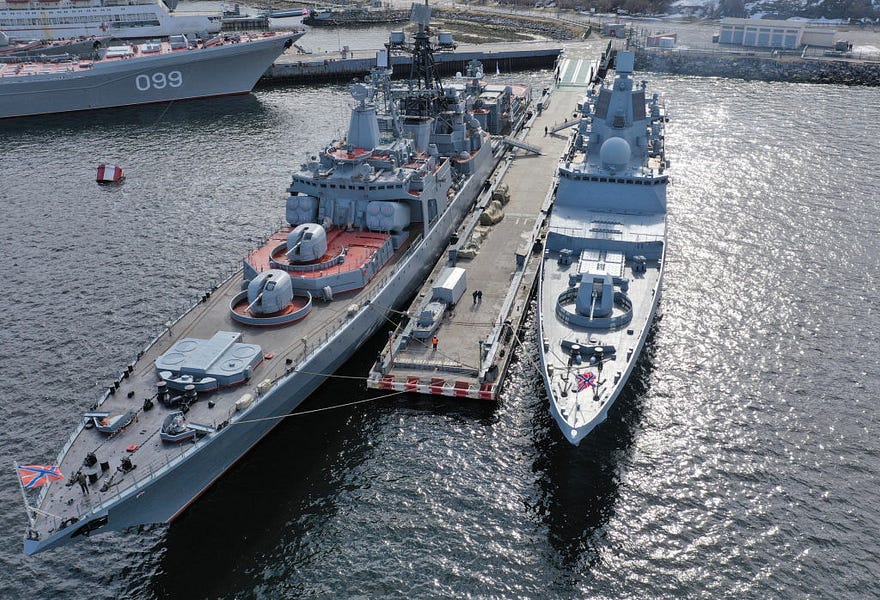When Secretary of State Antony Blinken and Russian Foreign Minister Sergey Lavrov meet face-to-face for the first time in Reykjavik, Iceland, later this month, the pair will have no shortage of issues to sort through.
Biden’s first months in office have embraced a markedly “tough on Russia” posturing—in rhetoric if not always in action—and the Kremlin has taken note. Moscow, meanwhile, has repeatedly tested the patience and resolve of the new administration through its cyberattacks targeting foreign entities, its widely condemned imprisonment of opposition leader Alexei Navalny, its attempted meddling in the November election, and its continued occupation of Crimea.
While these high-profile points of contention could surface in the event that Biden and Russian President Vladimir Putin convene in June, the topic of the day from May 16-18 is one that has long flown under the radar: the Arctic.
Envoys from the U.S. will convene alongside the representatives of seven other Arctic states, indigenous peoples organizations, and non-Arctic observer countries to pass the Arctic Council chairmanship from Iceland to the Russian Federation. In true multilateral fashion, the group will collaborate on topics of mutual concern, including environmental protection, search and rescue plans, and access to resources.
It’s a seemingly innocuous first meeting for two great powers with little else in common. But as climate change transforms the landscape of the Arctic’s permanent sea ice cover, widening waterways offer new arenas for economic competition and military confrontation. And in contrast to its dominance in both fronts worldwide, Washington is unprepared to meet the challenges posed by Moscow in the historically neglected but fast-emerging region.
With 15,000 miles of Arctic coastline to Alaska’s 2,500, Russia’s conception of itself as the predominant Arctic superpower is a point of national pride that dates back to the Soviet era. Under Joseph Stalin, the country’s northern reaches hosted the regime’s most forbidding internment camps, serving the dual purpose of inspiring fear among perceived enemies of the state and extracting the terrain’s untapped resources through forced labor.
The Arctic now accounts for at least 10 percent of Russia’s GDP and about 20 percent of its exports, so it’s fair to say that Putin’s aggressive maneuvers in the region—like stationing S-400 missile systems, reopening Soviet military bases, and strengthening airfields—are owed in part to the defense of critical infrastructure. But as Russia’s military exercises near NATO airspace pick up in both frequency and force, the Kremlin appears poised to project its dominance in the Arctic and surrounding regions.
On a single day in March, for example, Moscow deployed about 10 fighter jets and patrol aircrafts to the Barents, Baltic, Norwegian, and North seas without warning.
Russian flyovers in the Alaska Air Defense Identification Zone—a buffer zone protecting U.S. and Canadian airspace—have also picked up. Lt. Gen. David Krumm, head of Alaskan Command, told an Air Force Association online forum last week that the exercises cause “strain” on his units. “We have certainly seen an increase in Russian activity. We intercepted over 60 aircraft last year.”
While Alaska will soon shelter the highest concentration of combat-ready, fifth-generation fighters in the nation with the arrival of 50 F-35A Lightning II fighter jets, its defensive capabilities have long focused on detecting and extinguishing threats from the Indo-Pacific. In the Arctic, more than six years after Russia began conducting large-scale snap military drills, the U.S. lags behind strategically and economically.
Moscow’s regional supremacy is in no small part thanks to its Northern Fleet, which for nearly 90 years has safeguarded Russian interests in the Arctic seas through its powerful presence and increasingly advanced capabilities. Alongside the naval fleet are nearly four dozen icebreakers, necessary to clear the way for warships and commercial vessels. The U.S., by comparison, has two—only one of which is equipped to traverse polar conditions, and both of which are badly dated and prone to malfunctions.
“Our ice-breaking capabilities are stretched to the very limit, and we have to hope that both of those icebreakers don’t have any further catastrophic mechanical failures,” said Heather Conley, senior vice president for Europe, Eurasia, and the Arctic at the Center for Strategic and International Studies. A heavy icebreaker is in the works to be completed by 2025, but Conley noted that the project’s timeline is “ambitious.”
Further complicating the U.S.’s position in the Arctic is China’s reach north. In a 2018 document outlining its Arctic policy, Beijing counterintuitively declared itself to be a “near-Arctic state” and argued that the region be treated as global commons. “The Arctic situation now goes beyond its original inter-Arctic States or regional nature, having a vital bearing on the interests of States outside the region and the interests of the international community as a whole, as well as on the survival, the development, and the shared future for mankind.”
Using the language of climate change—the sincerity of which from the world’s biggest carbon emitter is up for debate—China opposes the Arctic States’ exclusive jurisdiction over the region. As a mere observer on the Arctic Council, China can voice its opinion on policy matters but has very little sway.
Local enterprise and research are Beijing’s main inroads, which though not military in nature lay the groundwork for its future strategic influence. “They give China a space capacity and situational awareness. All of these things are useful should China decide at a future date that it needs a military presence in the Arctic,” Liselotte Odgaard, senior fellow at the Hudson Institute, told The Dispatch.
China also has its hand in numerous economic ventures across the Arctic, extending its global strategy of investing in infrastructure and energy to develop regional leverage.
Two state-owned companies, China National Petroleum Corporation (CNPC) and Silk Road Fund, hold roughly 30 percent stake in Yamal LNG—a massive liquified natural gas venture on Russia’s Yamal Peninsula. Chinese investors also plan to throw their funds behind a railway between Kirkenes, Norway and Finland; as well as a tunnel under the Baltic Sea connecting Helsinki and Tallinn, Estonia.
China eyes ports, naval bases, and airports across the region, and it encourages collaboration in the areas of fishing, navigation, mining, and pipeline laying. These projects were initially welcomed, but many local entities are now experiencing buyer’s remorse as they catch wind of the Chinese government’s concealed ambitions in the Arctic.
“Many local companies, municipalities, and decision-makers [will] probably continue to welcome Chinese investments as they would bring much needed jobs, business opportunities and finance to the remote areas,” the Arctic Institute’s Dr. Sanna Kopra told The Dispatch. “At the same time, potential investments in critical infrastructure can be expected to increasingly be scrutinised at national level, as security implications of China’s Arctic activities will no doubt be increasingly discussed and analysed in all the Arctic countries.”
When Beijing threatened to pull a trade deal with the Danish-owned Faroe Islands if they didn’t adopt Huawei’s 5G network, for example, the story leaked to the press and the Danes rejected the blackmail. Unlike other countries entangled in China’s global investments, most Arctic countries can afford to push back on Beijing.
“Even if the Arctic region is underdeveloped, it’s still part of well-off nations that could afford to invest in the Arctic if they gave it priority, so it’s harder for China to get in than it is in poorer parts of the world,” Odgaard said. “The Arctic is an integrated part of the West, except for—of course—Russia.”
Because of this duality among Arctic countries, onlookers have long sounded the alarms of a Sino-Russian strategic partnership. While China wants to develop its hard power in the region, Russia needs Chinese capital to live up to its lofty ambitions and a Chinese presence to counter NATO.
“China’s military has been involved in the last three Russian annual military exercises, of which there has been an Arctic component,” Conley told The Dispatch. “And we know the Russian Navy and the Chinese People’s Liberation Army Navy (PLAN) have been interacting and doing Naval exercises since 2015.”
“Just last month, Russia announced plans to connect the Northern Sea Route with China’s Maritime Silk Road, which would develop a new shipping channel from Asia to northern Europe. Meanwhile, China is already developing shipping lanes in the Arctic Ocean,” former Secretary of State Mike Pompeo said of the emerging relationship in 2019. “Do we want the Arctic Ocean to transform into a new South China Sea, fraught with militarization and competing territorial claims?”
But Moscow and Beijing are strange bedfellows. Russia’s claim to primacy in the Arctic is, by necessity, based in territorial sovereignty. Inviting a non-Arctic power to the table undermines that claim. And despite public cooperation to thumb the nose at the West, the Kremlin also harbors a deep suspicion of the Chinese government.
But while the power of the bilateral partnership may be overstated, the United States’ regional capabilities are still severely outpaced by Russia.
15,000 American service members—along with vessels, aircrafts, and armaments—convened this week in Alaska to run training exercises on the unfamiliar terrain. Other steps, like assessing the need for a deep water port and further developing unmanned technology to monitor the sea, could bolster the U.S.’s regional standing.
“We are an Arctic country, and the strategic long-term concerns of the Arctic—in both Alaska, as well as areas of Canada and Europe where we provide defense—are important to us,” Cameron Carlson, founding director of the Homeland Security and Emergency Management program at the University of Alaska, Fairbanks, told The Dispatch. “We are lagging behind. More needs to be done in the Arctic.”







Please note that we at The Dispatch hold ourselves, our work, and our commenters to a higher standard than other places on the internet. We welcome comments that foster genuine debate or discussion—including comments critical of us or our work—but responses that include ad hominem attacks on fellow Dispatch members or are intended to stoke fear and anger may be moderated.
With your membership, you only have the ability to comment on The Morning Dispatch articles. Consider upgrading to join the conversation everywhere.